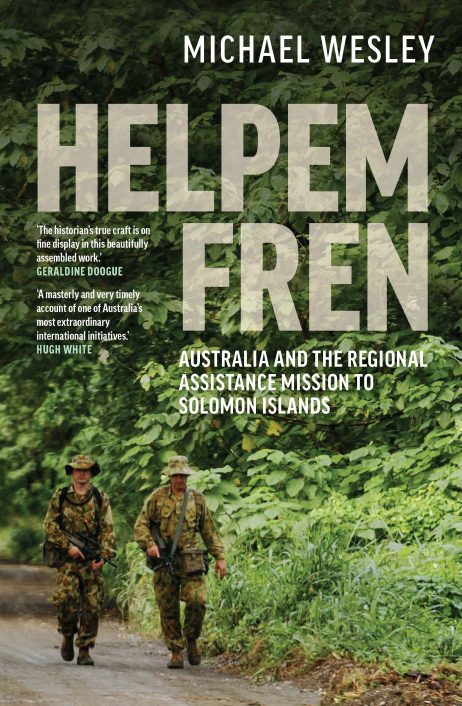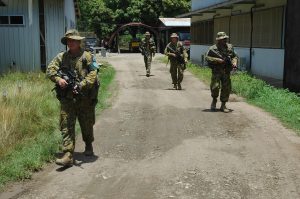Twenty years ago, as the first few months of 2003 passed, the political situation in Solomon Islands — uneasy since a 1998 spike in ethnic violence, a 2000 coup, and a peace agreement — remained unsteady, with violent gangs extorting the government. In April that year Solomon Islands Prime Minister Allan Kemakeza wrote at letter to his Australian counterpart John Howard requesting assistance. What came to be known as the Regional Assistance Mission to Solomon Islands (RAMSI) marked a sharp reversal in Australia foreign policy thinking, but one rooted not only in the geopolitical obsession of the era — “failed states” — but further back in Australia’s wary watching of its Pacific Island neighbors.
RAMSI, by most measures, was a success in ways other international interventions of the time were not. But when the mission concluded nearly 14 years later, it had faded from prominent view for the Australian public. In “Helpem Fren: Australia and the Regional Assistance Mission to Solomon Islands,” Michael Wesley — deputy vice-chancellor international at the University of Melbourne — set out to write a history of RAMSI from Australia’s viewpoint, with particular attention to how the mission fits into the wider arc of Australian foreign policy. The book, whose title repeats the name of the mission in Solomon Islands Pijin — meaning “help a friend” — comes at a time when Australia is again in a period of intense concern and focus on the Pacific, as China swoops through the region.
In the following interview, The Diplomat’s Managing Editor Catherine Putz talks with Wesley about the cycles of Australian foreign policy, RAMSI’s origins, and the mission’s legacy.
 In the very first chapter of the book, you start with the 1883 arrival of a Queensland police magistrate named Henry Chester in Port Moresby, Papua New Guinea. You write that that moment, and what followed, was critical in the development of a distinct Australian foreign policy. In that vein, what are the features of Australian foreign policy that have roots in this particular history?
In the very first chapter of the book, you start with the 1883 arrival of a Queensland police magistrate named Henry Chester in Port Moresby, Papua New Guinea. You write that that moment, and what followed, was critical in the development of a distinct Australian foreign policy. In that vein, what are the features of Australian foreign policy that have roots in this particular history?
Australia’s geographic preoccupation with the security of its place in the world grew from its growing perception of the geopolitical consequences of its location. As the conqueror of a large, rich island continent, Australia’s British settlers were aware that threats could emerge from the two large archipelagoes that they sat between: the South Pacific archipelago and the Southeast Asian archipelago. A preoccupation with keeping potentially hostile powers out of both of these island chains has formed a consistent thread in Australia’s foreign policy ever since.
As we have seen with the signing of a Solomon Islands-China Security Agreement in 2021, the emergence of a potentially hostile presence in one of the island groupings close to Australian shores has called forth a sustained and visceral response in Australian foreign and security policy.
At present we’re approaching, this coming summer, the 20-year anniversary of the beginning of RAMSI. Can you briefly describe the immediate context for the mission, the conflict that preceded the international intervention?
Solomon Islands had succumbed to a rising tide of ethnic conflict and criminality since 1998, when some of the original inhabitants of the island of Guadalcanal began a campaign to evict Malaitan settlers from their traditional lands. This in turn provoked a Malaitan response, gradually turning Guadalcanal and the national the capital, Honiara, into a contest between Guale and Malaitan militant groups, eventually displacing around one-third of the population of Guadalcanal. In June 2000, militants from the Malaitan Eagle Force staged a coup that removed reforming Prime Minister Bartholomew Ulufa’alu.
The Australian government had been watching these developments with concern, and along with New Zealand, brokered the Townsville Peace Agreement in October 2000. Both governments contributed to the International Peace Monitoring Team, a small grouping of unarmed peace observers charged with overseeing the implementation of the Peace Agreement. However, while the Peace Agreement defused the inter-ethnic element of the conflict, it failed to disarm the militants and its provisions for paying compensation to the militants fueled the militants’ growing appetite for violent criminality. Soon militants and their allies in the police were extorting money from the government at gunpoint.
In April 2003 Solomon Islands Prime Minister Allan Kemakeza wrote to his Australian counterpart John Howard, describing the criminality within the police and the dire state of the economy and requesting Australian assistance in addressing the spiral of criminality and economic collapse. The letter set off a drastic rethink of Australia’s policy toward its Pacific neighbors, which had emphasized an arms-length, disinterested approach to regional assistance. Reflecting the dominant thinking on state failure and state building interventions at the time, the Australian government formulated a concept of a regional state-building intervention. The Regional Assistance Mission to Solomon Islands (RAMSI) began its 14-year progress in July 2003.
In the first few months of 2003, the Australian political establishment made a remarkable about-face — from op-eds insisting Australia was “not about to recolonize the South Pacific” to deploying thousands of troops in concert with other regional states to the Solomon Islands. What factors most contributed to this momentous shift?
Australia’s arms-length policy toward the Pacific had been the product of long experience in its relations with the post-independence governments in the region. The terms of Australia’s engagement with the region had been established by the insistence of Pacific governments on relations of equality and non-interference within bodies such as the Pacific Island Forum, and also by a wariness within the Australian government of the dangers of moral hazard in becoming too closely involved in underwriting Pacific states.
The most significant factor in shifting Australia from this position was the post-9/11 preoccupation among the United States and its allies with the problem of “failed states” and their role in fostering transnational threats such as terrorism. An important report comparing the situation in Solomon Islands with Afghanistan, which had hosted al-Qaida, was the Australian Strategic Policy Institute report “Our Failing Neighbour,” in June 2003. The report cleverly combined a sense of Australian responsibility for its Pacific region with the possibility of contagion from the disorder reaching Australia to advocate for an Australian-led intervention into Solomon Islands. Making this prospect more imaginable had been Australia’s leading of the INTERFET force into East Timor in 1999.
RAMSI — also called Operation Helpem Fren, which means “help a friend” in Solomon Islands Pijin — lasted for nearly 14 years, ending in June 2017. It lasted through an age of rather disastrous international interventions (in Iraq and Afghanistan, most notably). Was RAMSI different, and how so?
In many ways, RAMSI relied on a “template” for stat- building interventions that was shared by several of the less successful interventions of the era. This was to suppress the violence and restore law and order first; then to work on rebuilding the economy and the institutions of public administration. It also had in common with other interventions a determination to remain aloof from local political processes.
The main difference between RAMSI and the other interventions was its decisive suppression of the violence and criminality and its restoration of law and order. Phase one of the intervention, meticulously planned by Australian police and military in the weeks before RAMSI’s insertion, focused on a process combining the arrest of militants and criminals, a comprehensive firearms amnesty backed by criminal sanctions, and an overwhelming demonstration of “shock and awe” in the form of military capabilities able to be deployed in the advent of resistance by militants.
By mid-August 2003, over 3,200 weapons had been surrendered and destroyed by RAMSI, and almost all of the significant militant leaders had been arrested. This translated into overwhelming public support and gratitude towards RAMSI by the local population, laying the goodwill and groundwork for the other economy-building and governance-promoting elements of the RAMSI mandate.
In concluding the book’s first chapter, you write that Australia’s engagement with the Pacific “is a record of long stretches of lassitude and inattention punctuated by intense periods of concern and engagement.” Where in that pattern is the modern Australian state? Is there interest, and political will, to break that cycle, or is this kind of ebb and flow unavoidable?
Australia is currently in an intense period of concern and engagement with the Pacific and Southeast Asia. The emergence of China’s interest in both regions has translated into real concern in Canberra, and much-needed investment in Australia’s diplomacy and development in both subregions. This is a concern that will likely continue for some time, given that China’s interest and capabilities are not likely to wane in the foreseeable future, that governments in Southeast Asia and the Pacific do not share Australia’s threat perceptions of China (rather seeing China’s interest as an opportunity to garner greater external support and opportunities), and that Australia’s major ally is as concerned about China’s activities as Canberra is.
And finally, you note in the book’s introduction that it is a history of RAMSI from an Australian perspective and cautioned readers “against finishing the book and thinking that there are not many different perspectives on RAMSI – there are.” With that in mind, I won’t ask about the legacy of RAMSI in Solomon Islands (and hope, like you, to hear that answer from a Solomon Islander perspective). Rather I’ll ask this: What are RAMSI’s legacies for Australia, Australia’s relations with the Solomon Islands, and Australian foreign policy more broadly?
Unfortunately, Australian society and government have largely forgotten the experience and legacies of RAMSI – this is one of the main reasons I wrote the book. So ironically one of the lessons of RAMSI is how unreflective our foreign policy making is, in that we seem to have ignored one of the most significant initiatives Australia has ever mounted.
As I argue in the conclusion, RAMSI is also an initiative confined to a particular period in history, when Australia was relatively confident, wealthy, and decisive in its dealings with the world. It is unlikely that Australian governments would even contemplate an initiative of that scale and risk today. This poses real dilemmas in terms of how Canberra would respond to serious instability in its neighbors in the future – particularly when strategic competitors such as China would also be part of the equation.
What is remarkable is how little strategic or diplomatic credit RAMSI left for Australia with the current Solomon Islands government of Manasseh Sogavare, who in recent years has switched diplomatic recognition from Taiwan to China and signed a security agreement with China despite Canberra’s concerns. A canny political operator, Sogavare knows that the China relationship is the best lever he has to both ensure continued Australian interest and generosity towards Solomon Islands, and to enable him to stand up to Canberra when he needs to. While RAMSI can be counted as a qualified success as an intervention, its longer-term legacy may be to demonstrate the limits of Australian power in an increasingly complex and contested region.

































